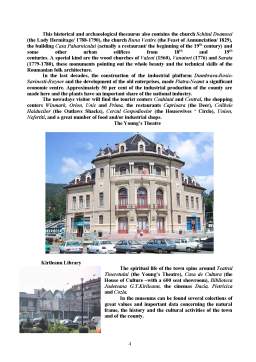Extras din referat
Tourism in Piatra-Neamt
The city of Piatra-Neamt is the administrative center of Neamt county and is situated in central-East Romania, between Eastern Carpathian Mountains and the sub-carpathian zone.
It is a land really quaint, surrounded by afforested hills lower than 1000 meters and crossed by the Bistrita river. This favourable site ensures easy road and railway connexions with all of the Moldavia regions, with Transilvania and with Romania’s capital, Bucharest.
Piatra-Neamt is one of the oldest sites of Romania. The archaeological works revealed that here was the powerful Petrodava of the geto-dacian period, settlement first mentioned in the 2nd century A.C. by the greek philosopher Ptolemeu. The best decades of Petrodava were between the 1st century B.C. and the 2nd century A.C. Its end was after the death of Decebal and his armies by the roman conquerors of Dacia (106 A.C.).
As everywhere in Roumanian teritorry, the people, firstly free Dacians, secondly, Daco-Romans and finally Roumanians, continued to live here in the “dark millenium” too (3rd to 13th century) despite the uninterrupted troubles and destructions made by migratory hordes. The archaeological documents reveal the existence of a feudal entrenchment in 12th and 13th centuries to protect a developing Roumanian site. A Russian list from 1330 specifies “Piatra” among the main towns of Moldavia. And in the 30th of January 1395, in a chancellery document, Sigismund of Luxembourg makes mention of this town too.
While the reign of Stephen the Great (1457-1504) a voivodal residence was built in Piatra-Neamt and was for a long period, the point of a teritorial-administrative unit including more than 30 rural sites.
The medieval town and the later city were built in closen relationship with the trade of cattle and grains but especially with the activities of wood processing and trade. In 1841 there was the first paper mill of Moldavia and after that there were built more workshops and factories with preponderant industrial features. All these bestowed to the town a growing economic significance.
The urbanistic development accompanied this economic growth: new municipal endowments and institutions for health, education and culture. In 1832 began the first public school and in 1869 was founded the first gymnasium, the actual “Petru Rares” secondary school, a very good one as from here emerged many of our culture and scientific personalities. The first hospital was founded in 1863. The first theatral stage was ready in 1871 and many of the best theatral groups of the times played on it. 1894 was the first year of using electrical energy to enlighten the town, only 12 years after New York, the first in the world with a power plant (1882).
The Memorial House of Calistrat Hogas
Here, on the wonderfuly banks of the Bistrita river and under the sights of this voivode of the mountains which is Ceahlaul, were born and worked several important personalities of the Roumanian cultural and artistic people: the writer Calistrat Hogas –unique “singer”of these places beauties, the teachers Ion Negre and Mihai Stamatin, the painters Lascar Vorel, Aurel Baesu and Victor Brauner –well known names in the national and european plastic arts, the scholar and editor G.T.Kirileanu, the archaeologist Constantin Matasa and many others.
This long existence through history gave to this town a high value heritage of historical and artistical monuments. Situated on a plateau overlooking the central part of the town, the monumental pile from the time of Stefan cel Mare still is an invaluable ornament of this old settlement. It is constituted by Curtea Domneasca (the Voivodal Court), the Church Sfantul Ioan (St. John) and the Tower.
Curtea Domneasca was founded between 1468 and 1475 and was firstly mentioned in a document from April 20, 1491. Today we have only fragments of the precincts wall and a part of the basement, all aranged for museum purposes.
On the contrary, the Church Sfantul Ioan has a very good condition even if it was erected in 1497-1498, and now is among the most valuable monuments of the country. The whole construction gives out equilibrium and elegance, these ones being reinforced by the clever system for attenuation of the vauts pressure and by richness of the external decorations made of polychrome enameled ceramics.
Preview document
Conținut arhivă zip
- Tourism in Piatra Neamt.doc




















